Soviet Computing School of Sergey Lebedev
Sergey Alekseevich Lebedev was a Soviet academician and the founder of computer technology in the USSR. He created the first computer in continental Europe with a program stored in memory (MESM) and was one of the developers of the first digital electronic computers with a dynamically changing computation program. Under the guidance and personal participation of this outstanding scientist, 18 computers were created, and 15 of them were mass-produced.
Lebedev was at the forefront of the development and formation of domestic computer technology. His experience is unique, as it covers the period from the creation of the first tube computers that performed hundreds and thousands of operations per second, to high-speed super-computers on large integrated circuits.
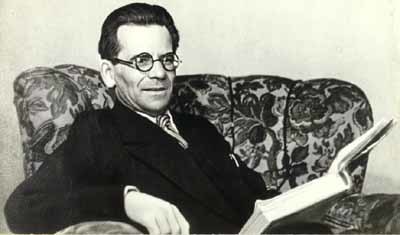
Sergey Lebedev was born on November 2, 1902 in the city of Nizhny Novgorod. Father Alexei Ivanovich was a well-known author of the ABC and the Dictionary of Inexplicable Words, and his mother Anastasia Petrovna (nee Mavrina, from the noblemen) taught general subjects in the lower grades of the public school. In the post-revolutionary years, the head of the family was invited to work as the People's Commissar of Education and the Lebedevs moved to Moscow.

Sergey Lebedev (1920)
In 1921, Sergei passed the externs exams for secondary school and entered the Moscow Higher Technical School (MVTU). N.E.Bauman at the Faculty of Electrical Engineering. His teachers and supervisors were prominent Russian scientists in electrical engineering, professors Karl Adolfovich Krug, Leonid Ivanovich Sirotinsky and Alexander Aleksandrovich Glazunov. All of them worked on the development of an electrification plan of the USSR (GOELRO plan). Successful implementation required unique theoretical and experimental research. Lebedev was still a student, but even then he focused on the problem of the stability of parallel operation of power plants. The first results on this issue were reflected in his graduation project, which was carried out under the guidance of Professor K.A. Krug.
In 1928, Lebedev received an electrical engineer diploma and remained teaching at his native alma mater, while simultaneously holding the post of junior research fellow at the All-Union Electrotechnical Institute (VEI). It was in this university that he headed the laboratory of electrical networks, where he continued to work on the problem of sustainability. The subject of the laboratory was gradually expanded, covering also the problems of automatic regulation. And as a result, in 1936, an automation department was formed on its basis, which Sergey Alekseevich was assigned to manage.
By this time, Lebedev had already become a professor and author (together with Peter Sergeyevich Zhdanov) of the monograph “Stability of parallel operation of electrical systems”, widely known among electrical engineers.
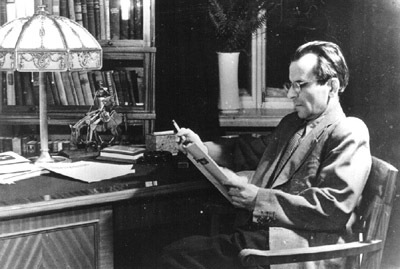
Lebedev in his office
Lebedev's scientific activity noted a characteristic feature, which consisted in an organic combination of a great depth of theoretical study with a specific practical orientation. Continuing theoretical research, he became an active participant in the preparation of the construction of the Kuibyshev hydroelectric complex.
At the beginning of World War II, Lebedev was forced to leave VEI and leave for Sverdlovsk. All resources of the automation department were switched to defense topics.
For a surprisingly short time in Sverdlovsk, Alexey Sergeyevich designed a system for stabilizing a tank gun when aiming. This development improved the tank, making it less vulnerable and thereby saving many tankers. The system allowed you to aim and shoot from a gun without stopping the machine. For his invention, the scientist was awarded the Order of the Red Banner of Labor and the medal "For Valiant Labor in the Great Patriotic War of 1941-1945."
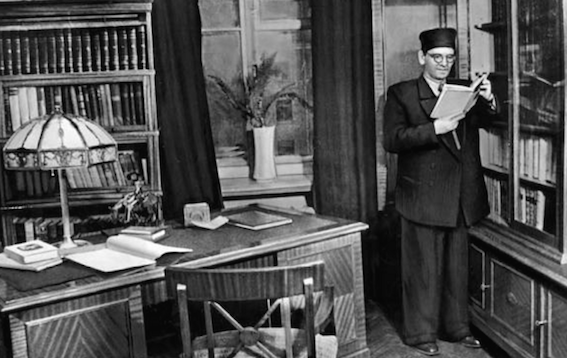
In 1945, Lebedev was elected a full member of the Academy of Sciences of the Ukrainian SSR
After the war ended, the scientist began to implement a long-planned project to create a computer using a binary number system. In those years, there were not enough complete publications about the binary number system and the method of operations on binary numbers. The basis for building a digital computer was the methodology for performing arithmetic operations in the binary number system and the methods previously developed by Lebedev himself for solving mathematical problems.
In 1947, Lebedev became director of the Institute of Electrical Engineering of the Academy of Sciences of Ukraine and, concurrently, headed the laboratory of the Institute of Precision Mechanics and Computer Engineering of the USSR.
In 1948, the process of creating a small electronic computer (MESM) began. For scientific work, Lebedev was allocated a partially destroyed building of the former monastery hotel in Feofania (Kiev). With the financial help and support of the vice-president of the Academy of Sciences of the Ukrainian SSR Mikhail Alekseevich Lavrentyev, the room was repaired and equipped as a laboratory.
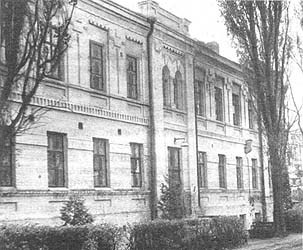
The building in Feofania, where the Lebedev laboratory was located
Lebedev put forward, substantiated and implemented in the first Soviet machine the principles of building a computer with a program stored in memory. MESM occupied the whole wing of a two-story building (60 m²) and consisted of 6,000 electronic lamps. It is noteworthy that the design, installation and debugging of the machine were completed within three years. At the same time, only 11 engineers and 15 technical staff participated in the development. Whereas the development of the world's first electronic computer ENIAC (USA) took five years and 13 developers and more than 200 technicians were involved.
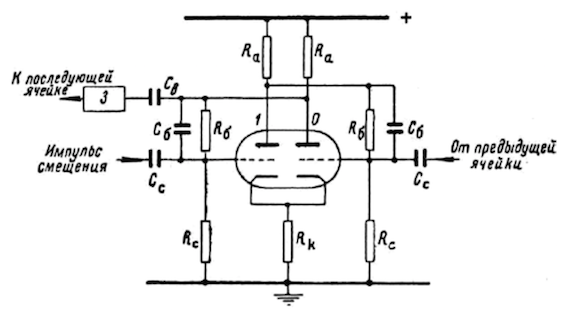
The unit cell diagram of the memory block of the arithmetic device MESM
MESM was an arithmetic device that performed operations of addition, subtraction, multiplication, division, shift, comparison taking into account the sign, comparison in absolute value, control transfer, transmission of numbers from the magnetic drum, addition of commands, stop. MESM had a binary representation of fixed-point numbers, 16 bits per number, plus one bit per sign.
On November 6, 1950, a test run of the machine took place, during which the problem was solved: Y '' + Y = 0; Y (0) = 0; Y (\ pi) = 0.
Despite the fact that MESM was created more like a model of a large electronic calculating machine, it found practical application. The first Soviet computer was very interested in mathematicians, whose tasks required the use of a high-speed computer. Until 1953, MESM was the only computer in the USSR.
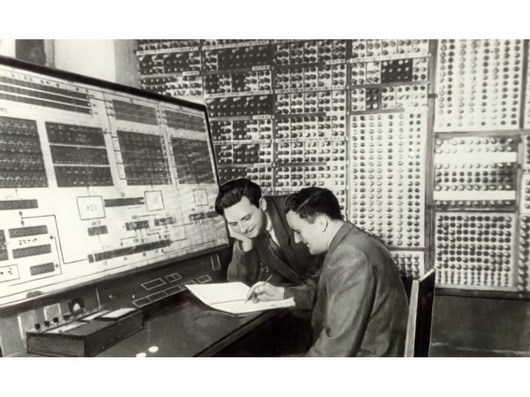
The participants in the development of MESM are Lev Naumovich Dashevsky and Solomon Beniaminovich Pogrebinsky (Kiev, 1951)
Characteristics of MESM
Element base: 6,000 electron tubes (about 3,500 triodes and 2,500 diodes)
Speed: 3,000 operations per second
Power consumption: about 25 kW
Discharge: 16
Clock frequency: 5 kHz
I / O devices: input from a punch card or by dialing a code on a plug-in switch; output using an electromechanical printing device or photo device to obtain data on film.
A magnetic drum could also be used, storing up to 5000 codes of numbers or commands.
The next after MESM was developed a large electronic computer (BESM). In the structure of the device, already then, the basic solutions typical of modern computers were implemented.
BESM had a binary number representation system taking orders into account, that is, in the form of floating point numbers. The machine operated on a range of numbers from about 10 -9 to 10 9 . The command system was three-address, it included 9 arithmetic operations, 8 code transfer operations, 6 logical operations, 9 control operations.
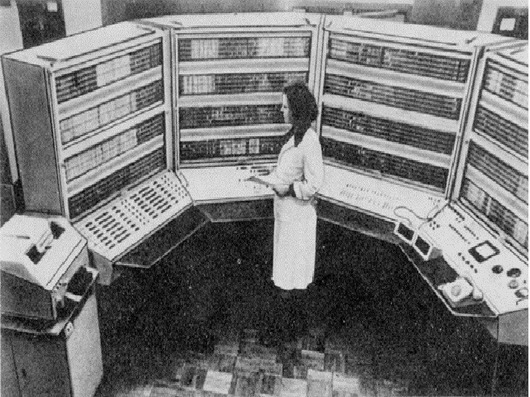
Laboratory tests BESM
BESM had 39 binary digits for representing numbers in the form of a mantissa / order, of which 32 bits were allocated for the significant part and 5 for order. Another category was reserved for the signs of the mantissa and order. When writing programs for the machine, the technique of self-modifying code was used, when the address parts of commands for accessing arrays were directly modified.
One of the developers of BESM Vsevolod Sergeevich Burtsev remembers the following about the car:
BESM characteristics
Element base: 4,000 electronic tubes, 5,000 semiconductor diodes
Speed: 8,000 operations per second
Power consumption: about 35 kW
Bit: 39
Clock frequency: 9 MHz
External memory: on magnetic drums (2 drums of 5120 words each) and magnetic tapes (4 to 30,000 words)
I / O devices: punch card input, digital printing and photo printing device.
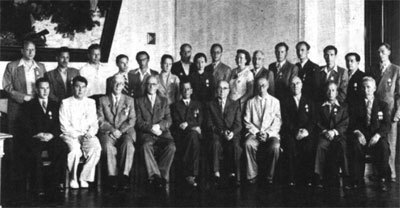
A group of ITM and VT Academy of Sciences of the USSR on the day of rewarding for the creation of BESM (1956)
In 1956, BESM received an award and was accepted into operation by the State Commission.
In 1958, BESM was prepared for serial production. The ITM&VT team, under the leadership of Lebedev, developed and presented two computers: BESM-2 and M-20. Their characteristic feature was that they were developed in close contact with industry (especially the M-20). Specialists of the plant and the academic institute together participated in the creation of the machine. This principle was good because it improved the quality of documentation, because it took into account the technological capabilities of the plant.
The BESM-2 computer retained the command system and all the basic parameters of the previous device, but the design became more technologically advanced and convenient for serial production. In BESM-2, random access memory on ferrite cores was implemented, semiconductor diodes were widely used, and the design (small block) was improved. At BESM-2, calculations were carried out related to the launch of artificial satellites, the first manned spacecraft. It was on one of the mentioned computers that the trajectory of the rocket that delivered the USSR pennant to the moon was calculated.

BESM-2 had about 4,000 electronic tubes, and was assembled on three main racks.
Characteristics of BESM-2
Element base: 4,000 electronic tubes, 5,000 semiconductor diodes
Speed: 20,000 operations per second
Power consumption: 35 kW
Bit: 45
Clock frequency: 10 MHz
External memory: on magnetic drums and magnetic tapes
I / O devices: input from the punched tape that the device prints.
M-20 became the first Soviet machine, which was supplied complete with special mathematical software (in essence - the OS). Lebedev laid down a number of constructive solutions in the new device, expanding the functionality and almost not increasing the number of electronic tubes.
The M-20 had a capacity of 20,000 operations per second due to the combination of individual devices and faster arithmetic operations. The machine was first used: automatic address modification; combining the operation of an arithmetic device and fetching instructions from memory; Use of buffer memory for print arrays.
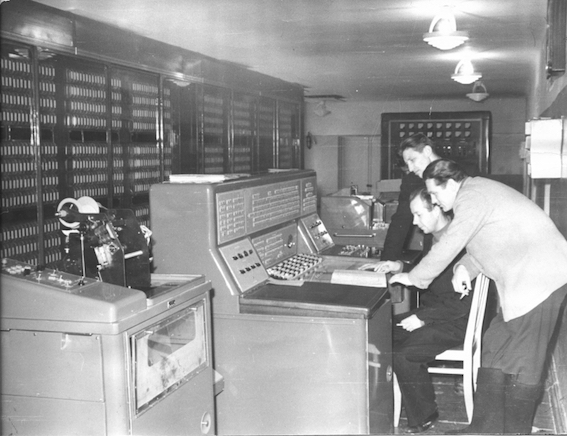
M-20
Characteristics M-20
Element base: electronic lamps, semiconductor circuits
Speed: 20,000 operations per second
Power consumption: 50 kW
Bit: 45
Clock frequency: 0.6667 MHz
External memory: on magnetic drums and magnetic tapes
I / O devices: input with a punched tape which the device prints

After the presentation of awards in the Kremlin (1962).
In 1965, a serial computer on the semiconductor elements BESM-4 appeared, which inherited the architecture of the M-20. For BESM-4, there were at least 3 different compilers from the Algol-60 language, the Fortran compiler, at least 2 different assemblers, the compiler from the original Epsilon language.
Characteristics of BESM-4
Element base: electronic lamps, semiconductor circuits
Speed: up to 40,000 operations per second
Power consumption: 50 kW
Bit: 45
Clock frequency: 9 MHz
External memory: on magnetic drums and magnetic tapes
I / O devices: input from punched tape that the device is printing
The development of BESM-6 was completed at the end of 1965. This machine was the first Soviet super-computer based on the second-generation element base (semiconductor transistors). BESM-6 electronic circuits used 60,000 transistors and 180,000 semiconductor diodes. The elemental base was new for that time.
BESM-6 had a main or water supply management principle. With its help, streams of instructions and operands were processed in parallel. In the development, associative memory was used on ultrafast registers, which reduced the number of calls to ferritic memory and allowed for local optimization of calculations in the dynamics of the count. RAM had a bundle (8-layer) into autonomous modules, which made it possible to simultaneously access memory blocks in several directions. The multi-program operation mode of BESM-6 made it possible to solve several problems with given priorities. The hardware mechanism for converting a mathematical address into a physical one made it possible to dynamically allocate RAM in the process of computing by means of the OS.
BESM-6 had a conveyor central processor with separate conveyors for the control device and arithmetic device. It allowed to combine the processing of several teams at different stages of execution. There was a cache of 16 48-bit words (4 data reads, 4 read commands, 8 - write buffer). The instruction system included 50 24-bit instructions.
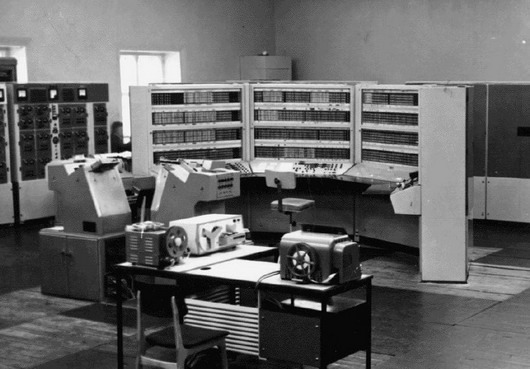
Laboratory for conducting final tests of the famous BESM-6
Since 1968, the production of BESM-6 began at the plant of computer-analytical machines (CAM) in Moscow.
Characteristics of BESM-6
Element base: transistor paraphase amplifier with diode logic at the input
Speed: about 1 million operations per second
Power consumption: 60 kW
Bit: 48
Clock frequency: 10 MHz
External memory: on magnetic tapes and magnetic disks
I / O devices: punch card input, digital printing and photo printing device

At the Open Day of the Faculty of Computational Mathematics and Cybernetics of Moscow State University Vladimir Ponomarev demonstrates the game “Kalah” on the screen of the BESM-6 terminal
Since 1967 practically all major computing centers of the USSR began to be equipped with BESM-6 computers. And even after years at a meeting of the Department of Informatics, Computer Engineering and Automation of the Academy of Sciences (1983), Academician E.P. Velikhov said that the creation of BESM-6 was one of the main contributions of the USSR Academy of Sciences to the development of Soviet industry.
In 1990, one of the BESM-6 units was transported to London and installed at the Museum of Science as the best supercomputer of its time in Europe.
The 5E26 computer was Lebedev's last lifetime development, which he managed to launch into serial production.
In 1968, Lebedev accepted the proposal of Boris Vasilyevich Bunkin, General Designer of anti-aircraft missile systems for air defense. He agreed to develop a specialized managing small-sized mobile high-performance digital computer complex (CVC) 5E26. Sergei Alekseevich dreamed of realizing such an opportunity even when creating MESM. Thanks to this work, the largest reorganization of the institute was carried out. The pooling of resources of many different laboratories led to the actual creation of departments:
- for general purpose
computers - for special purpose computers (including architecture)
- for electronic design
- for storage devices
- for CAD and technology.
Vsevolod Sergeyevich Burtsev (Lebedev's deputy) proposed the multiprocessor architecture of the CVC 5E26, which provides operation of up to three central processor modules and two special information input-output processors with shared memory.
Structurally, the 5E26 series CVC was a cabinet with a height of 1885 mm, a width of 2870 mm, a depth of 655 mm, which was placed against the wall of the vehicle.
The 5E26 had a highly efficient automatic backup system based on hardware control. The system made it possible to restore the control process in the event of malfunctions and failures of equipment operating in a wide range of climatic and mechanical influences, with developed mathematical software for automation of programming.

CCV 5E261
CCV 5E26 easily adapted to various performance and memory requirements in special-purpose control systems. The device also worked in real time, equipped with advanced mathematical software, an effective programming automation system and the ability to work with high-level languages. In 5E26, a non-volatile memory of instructions was implemented on microbiases with the possibility of electric rewriting of information by external recording equipment, and an effective operating system was introduced with two-level localization of the faulty cell, which ensures the efficiency of restoration of equipment by medium-technical personnel.
As integrated circuits, mainly semiconductor microcircuits of one of the first domestic series-133 and 130 (TTL type) were used.
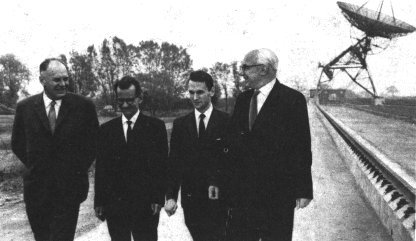
Lebedev during a trip to England (Cambridge, 1964).
Characteristics 5E261
Element base: standard series of TTL microcircuits.
Speed: 1.5 million operations per second;
Power consumption: 5.5 kW
;
Capacity : 32; RAM: 32-34 Kb
The amount of command memory: 64-256 Kb
An independent input / output processor for information on 12 communication channels: the maximum exchange rate is over 1 Mb / s.
The experience of creating 5E26 computers became the basis for designing the Elbrus family of supercomputers. The name was proposed by Lebedev. The appearance of "Elbrus" completed the creation of the USSR missile defense system, but he himself no longer had time to take part in their development.
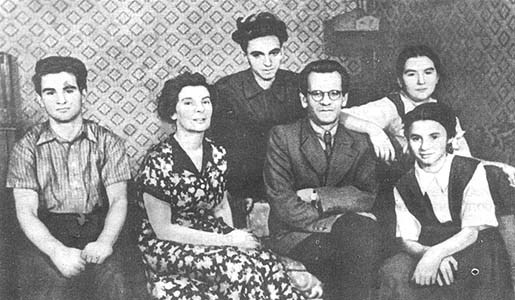
Lebedev with his family
According to the recollections of employees who worked with Sergey Alekseevich in Kiev, he was an ideal leader. In the work I brought everything to perfection, paid much attention to trifles. He never raised his voice and treated everyone exceptionally evenly, fairly, without bias. Always noted even the small successes of their employees. In the process of debugging the machine, he had no equal. Lebedev exceeded everyone in understanding the problems and malfunctions in the car.
Sergei Alekseevich throughout his life has done a great job of training scientific personnel. He was one of the initiators of the creation of the Moscow Institute of Physics and Technology, the founder and head of the department of computer engineering at this institute, and led the work of many graduate students and graduates.

Lebedev with his daughters Catherine and Natalia
In the early 70's, Sergei Alekseevich could no longer lead the Institute of Precision Mechanics and Computer Engineering, in 1973 a serious illness forced him to resign as director. But he continued to work at home.
Sergey Alekseevich Lebedev died on July 3, 1974 in Moscow. He was buried at the Novodevichy cemetery.
In Kiev, on the building where the Institute of Electrical Engineering of the Academy of Sciences of Ukraine was located, a memorial plaque hangs, the text of which reads: "In this building at the Institute of Electrical Engineering of the Academy of Sciences of the Ukrainian SSR in 1946-1951 worked as an outstanding scientist, creator of the first domestic electronic computer, Hero of Socialist Labor, academician Sergei Alekseevich Lebedev. ”

Mosaic depicting Lebedev in ITMiVT
In the year of the 95th anniversary of the birth of Sergei Alekseevich Lebedev, the merits of the scientist were recognized abroad. As an innovator in computer technology, he was awarded the inscribed medal of the International Computer Society with the inscription: “Sergey Alekseevich Lebedev, 1902-1974 ... Developer and designer of the first computer in the Soviet Union. The founder of Soviet computer engineering. "
Lebedev was at the forefront of the development and formation of domestic computer technology. His experience is unique, as it covers the period from the creation of the first tube computers that performed hundreds and thousands of operations per second, to high-speed super-computers on large integrated circuits.

Sergey Lebedev was born on November 2, 1902 in the city of Nizhny Novgorod. Father Alexei Ivanovich was a well-known author of the ABC and the Dictionary of Inexplicable Words, and his mother Anastasia Petrovna (nee Mavrina, from the noblemen) taught general subjects in the lower grades of the public school. In the post-revolutionary years, the head of the family was invited to work as the People's Commissar of Education and the Lebedevs moved to Moscow.

Sergey Lebedev (1920)
The beginning of the way
In 1921, Sergei passed the externs exams for secondary school and entered the Moscow Higher Technical School (MVTU). N.E.Bauman at the Faculty of Electrical Engineering. His teachers and supervisors were prominent Russian scientists in electrical engineering, professors Karl Adolfovich Krug, Leonid Ivanovich Sirotinsky and Alexander Aleksandrovich Glazunov. All of them worked on the development of an electrification plan of the USSR (GOELRO plan). Successful implementation required unique theoretical and experimental research. Lebedev was still a student, but even then he focused on the problem of the stability of parallel operation of power plants. The first results on this issue were reflected in his graduation project, which was carried out under the guidance of Professor K.A. Krug.
In 1928, Lebedev received an electrical engineer diploma and remained teaching at his native alma mater, while simultaneously holding the post of junior research fellow at the All-Union Electrotechnical Institute (VEI). It was in this university that he headed the laboratory of electrical networks, where he continued to work on the problem of sustainability. The subject of the laboratory was gradually expanded, covering also the problems of automatic regulation. And as a result, in 1936, an automation department was formed on its basis, which Sergey Alekseevich was assigned to manage.
By this time, Lebedev had already become a professor and author (together with Peter Sergeyevich Zhdanov) of the monograph “Stability of parallel operation of electrical systems”, widely known among electrical engineers.

Lebedev in his office
Lebedev's scientific activity noted a characteristic feature, which consisted in an organic combination of a great depth of theoretical study with a specific practical orientation. Continuing theoretical research, he became an active participant in the preparation of the construction of the Kuibyshev hydroelectric complex.
At the beginning of World War II, Lebedev was forced to leave VEI and leave for Sverdlovsk. All resources of the automation department were switched to defense topics.
For a surprisingly short time in Sverdlovsk, Alexey Sergeyevich designed a system for stabilizing a tank gun when aiming. This development improved the tank, making it less vulnerable and thereby saving many tankers. The system allowed you to aim and shoot from a gun without stopping the machine. For his invention, the scientist was awarded the Order of the Red Banner of Labor and the medal "For Valiant Labor in the Great Patriotic War of 1941-1945."

In 1945, Lebedev was elected a full member of the Academy of Sciences of the Ukrainian SSR
After the war ended, the scientist began to implement a long-planned project to create a computer using a binary number system. In those years, there were not enough complete publications about the binary number system and the method of operations on binary numbers. The basis for building a digital computer was the methodology for performing arithmetic operations in the binary number system and the methods previously developed by Lebedev himself for solving mathematical problems.
In 1947, Lebedev became director of the Institute of Electrical Engineering of the Academy of Sciences of Ukraine and, concurrently, headed the laboratory of the Institute of Precision Mechanics and Computer Engineering of the USSR.
MESM
In 1948, the process of creating a small electronic computer (MESM) began. For scientific work, Lebedev was allocated a partially destroyed building of the former monastery hotel in Feofania (Kiev). With the financial help and support of the vice-president of the Academy of Sciences of the Ukrainian SSR Mikhail Alekseevich Lavrentyev, the room was repaired and equipped as a laboratory.
The building in Feofania, where the Lebedev laboratory was located
Lebedev put forward, substantiated and implemented in the first Soviet machine the principles of building a computer with a program stored in memory. MESM occupied the whole wing of a two-story building (60 m²) and consisted of 6,000 electronic lamps. It is noteworthy that the design, installation and debugging of the machine were completed within three years. At the same time, only 11 engineers and 15 technical staff participated in the development. Whereas the development of the world's first electronic computer ENIAC (USA) took five years and 13 developers and more than 200 technicians were involved.

The unit cell diagram of the memory block of the arithmetic device MESM
MESM was an arithmetic device that performed operations of addition, subtraction, multiplication, division, shift, comparison taking into account the sign, comparison in absolute value, control transfer, transmission of numbers from the magnetic drum, addition of commands, stop. MESM had a binary representation of fixed-point numbers, 16 bits per number, plus one bit per sign.
On November 6, 1950, a test run of the machine took place, during which the problem was solved: Y '' + Y = 0; Y (0) = 0; Y (\ pi) = 0.
Despite the fact that MESM was created more like a model of a large electronic calculating machine, it found practical application. The first Soviet computer was very interested in mathematicians, whose tasks required the use of a high-speed computer. Until 1953, MESM was the only computer in the USSR.

The participants in the development of MESM are Lev Naumovich Dashevsky and Solomon Beniaminovich Pogrebinsky (Kiev, 1951)
Characteristics of MESM
Element base: 6,000 electron tubes (about 3,500 triodes and 2,500 diodes)
Speed: 3,000 operations per second
Power consumption: about 25 kW
Discharge: 16
Clock frequency: 5 kHz
I / O devices: input from a punch card or by dialing a code on a plug-in switch; output using an electromechanical printing device or photo device to obtain data on film.
A magnetic drum could also be used, storing up to 5000 codes of numbers or commands.
BESM
The next after MESM was developed a large electronic computer (BESM). In the structure of the device, already then, the basic solutions typical of modern computers were implemented.
BESM had a binary number representation system taking orders into account, that is, in the form of floating point numbers. The machine operated on a range of numbers from about 10 -9 to 10 9 . The command system was three-address, it included 9 arithmetic operations, 8 code transfer operations, 6 logical operations, 9 control operations.

Laboratory tests BESM
BESM had 39 binary digits for representing numbers in the form of a mantissa / order, of which 32 bits were allocated for the significant part and 5 for order. Another category was reserved for the signs of the mantissa and order. When writing programs for the machine, the technique of self-modifying code was used, when the address parts of commands for accessing arrays were directly modified.
One of the developers of BESM Vsevolod Sergeevich Burtsev remembers the following about the car:
In many blocks of the first BESM in the anode circuit, not resistance lamps, but ferrite transformers were used. Since these transformers were made in a handicraft way, they often faded, while emitting a pungent specific smell. Sergei Alekseevich had a wonderful sense of smell and, sniffing the rack, pointed to a defective one up to the block. He almost never made a mistake.
BESM characteristics
Element base: 4,000 electronic tubes, 5,000 semiconductor diodes
Speed: 8,000 operations per second
Power consumption: about 35 kW
Bit: 39
Clock frequency: 9 MHz
External memory: on magnetic drums (2 drums of 5120 words each) and magnetic tapes (4 to 30,000 words)
I / O devices: punch card input, digital printing and photo printing device.

A group of ITM and VT Academy of Sciences of the USSR on the day of rewarding for the creation of BESM (1956)
In 1956, BESM received an award and was accepted into operation by the State Commission.
BESM-2, M-20 and BESM-4
In 1958, BESM was prepared for serial production. The ITM&VT team, under the leadership of Lebedev, developed and presented two computers: BESM-2 and M-20. Their characteristic feature was that they were developed in close contact with industry (especially the M-20). Specialists of the plant and the academic institute together participated in the creation of the machine. This principle was good because it improved the quality of documentation, because it took into account the technological capabilities of the plant.
The BESM-2 computer retained the command system and all the basic parameters of the previous device, but the design became more technologically advanced and convenient for serial production. In BESM-2, random access memory on ferrite cores was implemented, semiconductor diodes were widely used, and the design (small block) was improved. At BESM-2, calculations were carried out related to the launch of artificial satellites, the first manned spacecraft. It was on one of the mentioned computers that the trajectory of the rocket that delivered the USSR pennant to the moon was calculated.

BESM-2 had about 4,000 electronic tubes, and was assembled on three main racks.
Characteristics of BESM-2
Element base: 4,000 electronic tubes, 5,000 semiconductor diodes
Speed: 20,000 operations per second
Power consumption: 35 kW
Bit: 45
Clock frequency: 10 MHz
External memory: on magnetic drums and magnetic tapes
I / O devices: input from the punched tape that the device prints.
M-20 became the first Soviet machine, which was supplied complete with special mathematical software (in essence - the OS). Lebedev laid down a number of constructive solutions in the new device, expanding the functionality and almost not increasing the number of electronic tubes.
The M-20 had a capacity of 20,000 operations per second due to the combination of individual devices and faster arithmetic operations. The machine was first used: automatic address modification; combining the operation of an arithmetic device and fetching instructions from memory; Use of buffer memory for print arrays.

M-20
Characteristics M-20
Element base: electronic lamps, semiconductor circuits
Speed: 20,000 operations per second
Power consumption: 50 kW
Bit: 45
Clock frequency: 0.6667 MHz
External memory: on magnetic drums and magnetic tapes
I / O devices: input with a punched tape which the device prints

After the presentation of awards in the Kremlin (1962).
In 1965, a serial computer on the semiconductor elements BESM-4 appeared, which inherited the architecture of the M-20. For BESM-4, there were at least 3 different compilers from the Algol-60 language, the Fortran compiler, at least 2 different assemblers, the compiler from the original Epsilon language.
Characteristics of BESM-4
Element base: electronic lamps, semiconductor circuits
Speed: up to 40,000 operations per second
Power consumption: 50 kW
Bit: 45
Clock frequency: 9 MHz
External memory: on magnetic drums and magnetic tapes
I / O devices: input from punched tape that the device is printing
BESM-6
The development of BESM-6 was completed at the end of 1965. This machine was the first Soviet super-computer based on the second-generation element base (semiconductor transistors). BESM-6 electronic circuits used 60,000 transistors and 180,000 semiconductor diodes. The elemental base was new for that time.
BESM-6 had a main or water supply management principle. With its help, streams of instructions and operands were processed in parallel. In the development, associative memory was used on ultrafast registers, which reduced the number of calls to ferritic memory and allowed for local optimization of calculations in the dynamics of the count. RAM had a bundle (8-layer) into autonomous modules, which made it possible to simultaneously access memory blocks in several directions. The multi-program operation mode of BESM-6 made it possible to solve several problems with given priorities. The hardware mechanism for converting a mathematical address into a physical one made it possible to dynamically allocate RAM in the process of computing by means of the OS.
BESM-6 had a conveyor central processor with separate conveyors for the control device and arithmetic device. It allowed to combine the processing of several teams at different stages of execution. There was a cache of 16 48-bit words (4 data reads, 4 read commands, 8 - write buffer). The instruction system included 50 24-bit instructions.

Laboratory for conducting final tests of the famous BESM-6
Since 1968, the production of BESM-6 began at the plant of computer-analytical machines (CAM) in Moscow.
Characteristics of BESM-6
Element base: transistor paraphase amplifier with diode logic at the input
Speed: about 1 million operations per second
Power consumption: 60 kW
Bit: 48
Clock frequency: 10 MHz
External memory: on magnetic tapes and magnetic disks
I / O devices: punch card input, digital printing and photo printing device

At the Open Day of the Faculty of Computational Mathematics and Cybernetics of Moscow State University Vladimir Ponomarev demonstrates the game “Kalah” on the screen of the BESM-6 terminal
Since 1967 practically all major computing centers of the USSR began to be equipped with BESM-6 computers. And even after years at a meeting of the Department of Informatics, Computer Engineering and Automation of the Academy of Sciences (1983), Academician E.P. Velikhov said that the creation of BESM-6 was one of the main contributions of the USSR Academy of Sciences to the development of Soviet industry.
In 1990, one of the BESM-6 units was transported to London and installed at the Museum of Science as the best supercomputer of its time in Europe.
5E26 Series
The 5E26 computer was Lebedev's last lifetime development, which he managed to launch into serial production.
In 1968, Lebedev accepted the proposal of Boris Vasilyevich Bunkin, General Designer of anti-aircraft missile systems for air defense. He agreed to develop a specialized managing small-sized mobile high-performance digital computer complex (CVC) 5E26. Sergei Alekseevich dreamed of realizing such an opportunity even when creating MESM. Thanks to this work, the largest reorganization of the institute was carried out. The pooling of resources of many different laboratories led to the actual creation of departments:
- for general purpose
computers - for special purpose computers (including architecture)
- for electronic design
- for storage devices
- for CAD and technology.
Vsevolod Sergeyevich Burtsev (Lebedev's deputy) proposed the multiprocessor architecture of the CVC 5E26, which provides operation of up to three central processor modules and two special information input-output processors with shared memory.
Structurally, the 5E26 series CVC was a cabinet with a height of 1885 mm, a width of 2870 mm, a depth of 655 mm, which was placed against the wall of the vehicle.
The 5E26 had a highly efficient automatic backup system based on hardware control. The system made it possible to restore the control process in the event of malfunctions and failures of equipment operating in a wide range of climatic and mechanical influences, with developed mathematical software for automation of programming.

CCV 5E261
CCV 5E26 easily adapted to various performance and memory requirements in special-purpose control systems. The device also worked in real time, equipped with advanced mathematical software, an effective programming automation system and the ability to work with high-level languages. In 5E26, a non-volatile memory of instructions was implemented on microbiases with the possibility of electric rewriting of information by external recording equipment, and an effective operating system was introduced with two-level localization of the faulty cell, which ensures the efficiency of restoration of equipment by medium-technical personnel.
As integrated circuits, mainly semiconductor microcircuits of one of the first domestic series-133 and 130 (TTL type) were used.

Lebedev during a trip to England (Cambridge, 1964).
Characteristics 5E261
Element base: standard series of TTL microcircuits.
Speed: 1.5 million operations per second;
Power consumption: 5.5 kW
;
Capacity : 32; RAM: 32-34 Kb
The amount of command memory: 64-256 Kb
An independent input / output processor for information on 12 communication channels: the maximum exchange rate is over 1 Mb / s.
The experience of creating 5E26 computers became the basis for designing the Elbrus family of supercomputers. The name was proposed by Lebedev. The appearance of "Elbrus" completed the creation of the USSR missile defense system, but he himself no longer had time to take part in their development.
Afterword
Lebedev with his family
According to the recollections of employees who worked with Sergey Alekseevich in Kiev, he was an ideal leader. In the work I brought everything to perfection, paid much attention to trifles. He never raised his voice and treated everyone exceptionally evenly, fairly, without bias. Always noted even the small successes of their employees. In the process of debugging the machine, he had no equal. Lebedev exceeded everyone in understanding the problems and malfunctions in the car.
Sergei Alekseevich throughout his life has done a great job of training scientific personnel. He was one of the initiators of the creation of the Moscow Institute of Physics and Technology, the founder and head of the department of computer engineering at this institute, and led the work of many graduate students and graduates.

Lebedev with his daughters Catherine and Natalia
In the early 70's, Sergei Alekseevich could no longer lead the Institute of Precision Mechanics and Computer Engineering, in 1973 a serious illness forced him to resign as director. But he continued to work at home.
Sergey Alekseevich Lebedev died on July 3, 1974 in Moscow. He was buried at the Novodevichy cemetery.
In Kiev, on the building where the Institute of Electrical Engineering of the Academy of Sciences of Ukraine was located, a memorial plaque hangs, the text of which reads: "In this building at the Institute of Electrical Engineering of the Academy of Sciences of the Ukrainian SSR in 1946-1951 worked as an outstanding scientist, creator of the first domestic electronic computer, Hero of Socialist Labor, academician Sergei Alekseevich Lebedev. ”

Mosaic depicting Lebedev in ITMiVT
In the year of the 95th anniversary of the birth of Sergei Alekseevich Lebedev, the merits of the scientist were recognized abroad. As an innovator in computer technology, he was awarded the inscribed medal of the International Computer Society with the inscription: “Sergey Alekseevich Lebedev, 1902-1974 ... Developer and designer of the first computer in the Soviet Union. The founder of Soviet computer engineering. "
